
Sigma SD14 Resolution: 14 MP? 4.6 MP?
How does the SD14 stack up against high end cameras like the Canon
EOD 5D?
by Mike Chaney
03/16/2007
 |
Want to print beautiful 13 x 20 inch or larger prints from your SD14? Make the most of your megapixels and let Qimage professional photographic printing software show you both size and quality you never thought possible from your own printer! Give the Windows/PC 30 day demo a try today. |
Revisions:
03/17/07, 12:00am EDT: Added real
shot comparison
03/17/07, 02:00pm EDT: Revised resolution tests to include all primary colors
and updated text to coincide w/new tests!
03/21/07, 10:30am EDT: Added 20D resolution tests and a write up on where the
SD14 stands among other dSLR's.
04/18/07, 04:30pm EDT: Update regarding problems I've been having with
the SD14
04/21/07, 07:30pm EDT: Sigma replaced my SD14 and things are looking better
07/07/07, 07:45pm EDT: My final take on the SD14
07/11/07, 02:30pm EDT: One last set of photos to ponder
Background
This article has become a sort of diary for my own experience with the SD14 and the fun I've had comparing it to my Canon 5D during the spring/summer of 2007. I would encourage you to read the entire article as there have been some bumps in the road for the SD14 along the way. Fortunately, Sigma has stood by their product and in the end, has delivered a fine tool for photographers in the SD14. I hope you enjoy the article which started out as a purely technical article, and became a bit more over time as I gained more experience with the SD14 in more than just a technical perspective.
It's not often that I get excited enough about a new camera to take a look at some technical aspect of the camera, but whenever there is a fundamental change that could affect the future of digital photography, I like to discover just what the impact is and how it could affect future products. Being the owner of Digital Domain Inc. and the author of Qimage and Profile Prism, I don't have the time to do in depth camera reviews, take sample photographs, critique the camera body and controls, and so forth. What I can do is delve into the heart of what makes a new camera stand out from the pack. Since Sigma introduced the SD9 as the first prosumer full color capture camera, I've been hoping that the full color capture technology would take hold and we'd soon see the end of cameras using single color capture (Bayer mosaic) sensors. The RGBG sensors used in nearly all dSLR's today can only capture one of three primary colors at each pixel: red, green, or blue. The Foveon sensor used in the Sigma SD9/SD10 of yesteryear and the newly released SD14 can capture all three primary colors at each pixel site on the sensor.
While all other consumer/prosumer dSLR's capture only 1/3 of the color information for each pixel when compared to the SD14, what does this really mean as far as image quality? Is the SD14 really comparable to 14 megapixel cameras? How could it be when the SD14 produces a 4.6 megapixel final image? Sigma markets the SD14 as a 14 "megapixel" camera because it records 14 million pieces of information for each image. By comparison, a standard 14 MP dSLR also records 14 million pieces of information but it spreads the color information thin in order to gain resolution. Few people can in their own mind equate this to overall image quality to know what effect "full color capture" has on actual photos.
The "Bayer Blur"
Having spent years developing color interpolation algorithms that try to take one color per pixel and reconstruct the missing 2/3 of the information, I can tell you I have never been a big fan of the Bayer RGBG sensor design. In my opinion, it's simply a bad idea that has been implemented with enough finesse to make it quite effective given the obvious limitations. It's similar to the internal combustion engine which is also a very dated and relatively simple design that has been refined to the point that it actually works quite well. Capturing one color per pixel has inherent problems such as the fact that an antialiasing (basically blurring) filter must be used to spread light over a larger (than one pixel) area because at any pixel on the sensor, it takes a minimum of 9 pixels to capture all three primary colors! The fact that so many (adjacent) pixels are needed in order to estimate the color of any given pixel in the final image also means that edge detail and sharpness can suffer significantly when shooting subjects that only stimulate one or two of the primary colors. A deep red or blue subject suffers the most since the red and blue sensors only account for 1/4 of the pixels on the sensor. A red rose, for example, may be noticeably less sharp and the veins in the petals may be far less detailed on a standard dSLR because only the red pixels on the sensor are gathering any useful data. At that point, your 12.7 megapixel Canon 5D has just turned into a 3.2 MP camera. Fortunately, there are very few subjects that are the exact shade of red needed to only stimulate the red pixels on the sensor. Even a red rose will likely excite the green and/or blue sensors to some extent and even a little bit helps as that information (in the blue/green sensors) can still be used to resolve detail. Still, with the standard Bayer one-color-per-pixel design, resolving power will drop off at least to some degree whenever you are shooting a subject that is not black and white. Both theoretically and in practice, a standard camera's resolving power will begin to drop whenever a non-neutral color appears in the frame.
Bayer cameras and sharpness/detail variance
So what are the visual consequences of shooting with a camera where the resolving power and sharpness vary depending on the color being sampled? Basically, you end up with sharpness and detail inconsistencies. You may shoot a red rose petal lying on a concrete walkway only to find that the almost-gray concrete is tack sharp while the veins in the red flower petal look mottled in comparison. Why? Because all pixels on the sensor contain data for a gray object while only 1/4 of the pixels record significant data for a red subject. The end result in layman's terms is that the photo will look less "real" or will appear to have less "3D effect". I wrote an article about this for Digital Outback Photo in 2004 and it was the inspiration for the "sharpness equalizer" in Qimage which can recover sharpness based on reversing the detail inconsistencies with various colors on a Bayer sensor. While it's a far cry from actually being able to recover data that is lost due to the Bayer design, at least it does improve the 3D effect in Bayer images by recovering a bit of sharpness for highly saturated colors.
A brief look at the SD14
The SD14 is the newest entry using Foveon's full color capture sensor design in a Sigma camera. Full color capture means that all three colors (red, green, and blue) are captured at each pixel location on the sensor. Capturing full color eliminates the need for the "Bayer Blur", antialiasing, and the "finagling" of color around edges that can make some areas look unsharp on a standard camera. While the SD9/SD10 used similar technology, those cameras were more limiting in that they had no in-camera JPEG shooting mode, a necessity for some journalistic type work, and color was often a bit inconsistent under different lighting necessitating more color tweaking than would normally be necessary. Still, the 3D effect or "presence" of images from the SD9/SD10 was unrivaled. Until now! The SD14 has improvements in color accuracy, noise, and resolution that make it a solid contender that can compete with the best dSLR's on the market today.
To be honest, I never quite got the hang of my Canon 5D. It often underexposed even under relatively controlled conditions where my previous 300D, 10D, and 20D never had a problem, and I never quite got used to the full frame light falloff that can darken the corners of some shots near the wide end of the zoom range. Worse, I just could never get a shot from the 5D that I felt lived up to my expectations as far as sharpness and detail. This could be more a result of my lack of photographic skills than anything else since I don't proclaim to be a professional photographer, but it's odd that I never had trouble with my older 10D or 300D just as examples. To be honest, many of my 5D photos actually look gorgeous printed up to 13x20 and even beyond, but being on the software and engineering side of things, I'm a pixel peeper and I often expect to see excellent detail when viewing the image on screen at 1:1 (100% zoom) and it just wasn't there. Sure, the 5D has so many pixels that the amount of detail at 1:1 viewing on screen is of little consequence when printing, but it just might be a hint that all those extra pixels aren't quite adding up to what they should mathematically and that's why I'm so excited about what I'm seeing from the SD14 so far.
While I haven't taken enough shots with the SD14 to know if the color consistency problems that I had with the SD10 have been solved and if the camera does exactly what I need it to, it sure is producing shots that I'm personally much happier with right out of the box than the 5D has been able to give me in over a year working with it! Again, I'm not trying to "put down" the 5D because we all know that a photographer must pick his/her tools and without a doubt the 5D would be a better fit than the SD14 for others who are reading this, particularly if you happen to have a large investment in Canon lenses. For me, just after taking my first few dozen shots, I'm getting photos from the SD14 that are simply in a different league from (better than) what I was getting from the 5D. Is that just me? Am I just too lame to use the 5D properly. ;-) Maybe. Time will tell once the more photographically inclined reviewers start doing their real reviews of the SD14. For now, I'm beyond impressed with the SD14 and the few issues I've found with its operation appear minor and should be fixable with firmware updates! There is a bug in the v1.00 firmware that causes the "color space" selection of Adobe RGB to not stick as it should and the setting reverts to sRGB once the camera is powered down and back up. Actually, it only partly reverts because some indicators show Adobe RGB while others show sRGB so you really don't know what to think if you want to set the color space to Adobe RGB and keep it there. If you have firmware v1.00, I'd suggest choosing sRGB in the menu and leaving it there, as there appear to be multiple bugs related to choosing Adobe RGB. I'm sure a firmware fix could easily address that problem and it only affects JPEG shooting and not raw anyway which is where I spend most of my time. The jury is still out on battery life since after fully charging the battery, I only got about 15 shots before the battery indicator was at the half depleted mark on the display. From what I understand from others, the indicator seems to drop to halfway sooner than it should and I have shot another 30 or so shots since then with the indicator still sitting on the halfway mark so the indicator itself may be a bit liberal in its estimation of usage. One little oddity popped up when playing back images on the LCD in that I got some strange flashing/banding on the display. A power off/on fixed it and it was an LCD display issue only as the images were fine. It'll be interesting to see if that little glitch will pop up again. Other than these few things making me feel that firmware v1.00 might be a little glitchy, when you see the photos that this camera takes, the little things just don't matter any more!
Hit me with your first shot!
After charging the battery, the first thing I did was to pop up the flash and fire off a shot. At this point, my intent was to do nothing more than make sure the camera was working, that I could download and process the files, etc. I turned 90 degrees to my left where Jake was sitting in the window and fired off this shot which shot in raw (because that's the camera's default) and I developed as-is with no tweaks/changes. This was my first shot from the camera, and the WOW factor had already hit me like a freight train! With this first shot, I had already gone beyond the level of sharpness and detail I thought possible with a camera. I had been struggling for so long to get a shot with decent detail and sharpness with the 5D and I take one with the SD14 that blows me away just by "accident". From there, things just got better and better! Since I've always had to "fight" my 5D to get the proper exposure without tweaking the photos after the fact, I thought maybe my first shot was just a fluke. My second shot, however, had perfect exposure too, as have all 40-50 shots so far!
Resolution/detail: comparing the SD14 with the big boys
Revised 03/17/07: I have revised the resolution shots to include six primary colors (red, green, blue, yellow, magenta, and cyan). Red seems to be the worst case scenario for Bayer sensors so I wanted to get a more balanced measurement using various colors. As a result, much of this page from here forward has been revised.
Added 03/21/07: Added 20D resolution tests.
My findings with respect to the SD14's resolving power are about what I expected. Visually, the detail and 3D presence of SD14 photos are amazing, but I wanted to see if I could quantify this a bit. I already knew that as far as resolving power, the 5D would have the edge for black and white detail like that of a resolution chart, but what about the details in colorful subjects? Would things start to fall apart when photographing subjects close to primary colors like red or blue? Instead of looking at horizontal and vertical lines on a typical resolution chart, I chose to use star sector charts as they should be better suited for identifying the point at which both the 5D and SD14 are no longer able to resolve detail reliably. The charts below all start at 500 LPI (lines per inch) at the outer most point where the lines are the thickest. By measuring the distance from the outer edge to the point at which the lines start to blur together, we can calculate maximum resolution. While I confirmed that, as expected, the SD14 was able to resolve the same amount of detail regardless of color, Bayer cameras like the 5D will have more or less resolving power depending on the color being sampled.
Here are the resolution crops just as they came out of the cameras with no resizing or tweaks other than a click on white to fine tune white balance. If you are wondering about the reds, the SD14 appeared a bit weak on the reds while the 5D had a little too much punch in the reds. The actual red was somewhere between the two. Neither camera was perfect with respect to color accuracy under my mixed lighting but it was of little consequence for this test. Images from the 5D are labeled "C" for "Canon" and images from the SD14 are marked "S" for Sigma. Here, the SD14 images will obviously appear smaller because the SD14 produced final photos that are about 4.6 megapixels compared to the 5D's 12.7 megapixels.
Notes on the setup:
* Also tried Canon's DPP 2.0 for 5D and several other converters but Bibble produced the best resolution.
| Canon EOS 5D | Canon EOS 5D | Canon 20D | Canon 20D | Sigma SD14 | Sigma SD14 |
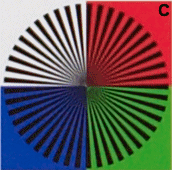 |
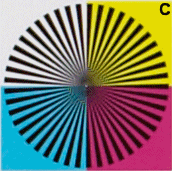 |
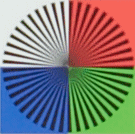 |
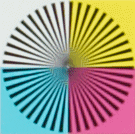 |
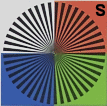 |
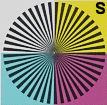 |
Measured Resolution
| Canon EOS 5D | Canon 20D | Sigma SD14 | |
| B/W | 2100 | 1700 | 1700 |
| Red | 1630 | 1400 | 1700 |
| Green | 2000 | 1680 | 1700 |
| Blue | 1750 | 1480 | 1700 |
| Yellow | 1950 | 1600 | 1700 |
| Magenta | 1800 | 1500 | 1700 |
| Cyan | 2000 | 1700 | 1700 |
| Average | 1890 | 1580 | 1700 |
The resolution values listed above represent the point at which the lines begin to blur/distort at any point around the arc of the circle. Imagine placing the pin of a protractor at the center of the chart and drawing concentric circles with the pencil starting at the outside edge of the chart and moving in. As you move in, the first point where your pencil-circle meets any lines in the graph that are blurred/smudged together, stop and the resolution can be measured at that point. Of course, since these are photos, we do this by using a photo editor and drawing circles digitally to see where the blurring/smudging starts. Since there are some heavy handed interpolation algorithms involved in reconstructing full color images from Bayer cameras like the 5D, it's a good idea to look at the resolving power at many angles and not just the horizontal, vertical, and 45 degree angles you see in the typical ISO-12223 resolution charts posted on digital camera review sites.
As expected, the 5D takes the lead on resolving power for B/W, but it also steps ahead on green, yellow, and cyan detail. The 5D's lead starts at about 24% for B/W detail but that advantage drops to about 18% when capturing green, yellow, and cyan colors. Due to the lack of a green component, the 5D's lead drops to only a 6% advantage for magenta, less than a 3% advantage for blue, and actually falls behind to a 4% deficit when capturing red colors which seem to be the worst case scenario for Bayer sensors. Why? While red and blue sensors are spaced identically on the sensor and one would expect the same resolving power for red and blue, blues fair a bit better simply because they often carry a weak green component, meaning that it is easier to find reds with no green component than blues with no green component.
While on average, the 5D does seem to have a 10% to 15% advantage in resolving power, by the numbers (megapixels in the final images), you'd expect a 65% advantage in all directions. The use of antialiasing filters and the complex color reconstruction algorithms are the primary reason that the 5D cannot realize the full 65% advantage. It is also important to note that while in some cases, the 5D pulled better max resolution than the SD14, the detail at that cutoff point was often very soft due to the amount of interpolation going on. In contrast, the SD14 was able to carry sharp detail all the way to its max resolving power, however, as a result of the lack of "smoothing" being done, the SD14's tradeoff was an increase in aliasing at or beyond max resolution. A tradeoff for sure. The worst part of the test for the 5D is that with resolving power varying by as much as 25% for some colors, the eye can pick up on the fact that some detail in the photo just isn't as sharp as it should be when the photo consists of subjects with widely varying color. The SD14's consistent resolving power give photos a more 3D appearance. It is important to preserve the relationship between detail, sharpness, and depth-of-field throughout the photograph and this is where Bayer cameras fall behind by not being able to reproduce the same realism as a full capture sensor under many shooting conditions. This effect is quite noticeable on the tests above as well as in real shots. If you look at the RGB chart for the 5D versus the SD14, the 5D makes the red and blue swatches look as if they are disconnected from (either in front or behind) the rest of the chart due to the obvious inconsistency in sharpness. The SD14 shows consistent sharpness all the way around as it should, and you can tell that all colors are on the same piece of paper.
Added (3/21/07): So where does the SD14 rank among other dSLR's as far as resolution?
The 8 megapixel 20D is unable to resolve as much overall detail as the SD14. Though they both resolve about the same amount of detail for B/W and green colors, the SD14 takes the lead for all other colors tested. From the data, we can infer that the overall resolving power of the SD14 lies somewhere between the 20D and the 5D: that is, somewhere between 8 megapixels and 12.7 megapixels. For overall resolving power, the SD14 appears to compare to a typical (Bayer) 10 MP dSLR. Keep in mind here that my findings that a Bayer based 10 MP dSLR resolves about 1700 LPI overall will be lower than the resolution measured by other review sites that only consider horizontal, vertical, and 45 degree detail from a single B/W chart because I consider lines at many different angles and a range of colors other than just B/W. Saying that the SD14 is approximately equivalent to a 10 MP Bayer dSLR, however, is a bit like comparing apples and oranges. A typical 10 MP dSLR may be able resolve detail as small as 1700 lines per inch, it does so a bit differently than the SD14.
When I state that both the SD14 and a standard 10 MP dSLR can resolve about 1700 lines per inch, I must qualify that statement. To my eyes, the SD14 produces better photos than a typical 10 MP dSLR because it is able to carry sharp detail all the way to the "falloff" point at 1700 LPI whereas contrast, color detail, and sharpness begin to degrade long before the 1700 LPI limit on a Bayer based 10 MP dSLR. Any Bayer dSLR will begin to lose significant chroma (color) information when different colors are being captured near the resolution limit. For example, tiny red spots on a white flower will begin to lose saturation as the dots become small enough to approach the resolution limits of the Bayer camera. In fact, the red dots will begin to start losing saturation as far back as 1000 LPI on the 10 MP Bayer camera while the SD14 will show a more accurate/vibrant red much further toward the 1700 LPI resolution limit.
As a consequence of the varying levels of sharpness, contrast, and color across different hues and spatial frequencies, many SD14 images look sharper and appear to have more 3D effect or "presence" when compared to Bayer based 10 MP photos. A necessary evil, however, to the fact that the SD14 can resolve pixel level detail is the fact that aliasing can appear more prevalent in SD14 photos, especially when you look at detail at or beyond its 1700 LPI resolution limit. To the observer, this can make SD14 photos appear jaggy in some areas and areas of repeating fine detail at or near the 1700 LPI limit can suffer from moiré. In some cases where repeating fine detail is being recorded, the 10 MP Bayer camera may actually produce less "distracting" photos as they tend to smooth over these artifacts. Unfortunately, they also smooth over some detail as well so as stated previously, the fight to balance aliasing and resolving power is a tradeoff. I tend to prefer the pixel level detail of the SD14 over the antialiasing methods of a standard dSLR however, because aliasing can be corrected via a number of blurring algorithms for photos where this is an issue, but once the data is "blurred" up front, there is no way to get the detail back.
The bottom line in the debate about where to place the SD14 among other (Bayer based) cameras is that I believe the SD14 to be about equivalent to a 10 MP Bayer dSLR as far as pure (maximum) resolution. When taking into account how the camera achieves that resolution, however, I would have to say for image quality, the SD14 compares well to standard dSLR's a little closer to 12 MP, that is, more comparable to something like the Canon 5D. When taking equivalent shots of "real" subjects and examining SD14 and 5D photos side by side, SD14 photos compare nicely to photos from the 5D. I've done a number of these tests and in scrolling around with my "pixel peeping" hat on, I can always find some areas that I like better on the SD14 and other areas that I like better from the 5D photos. For image quality alone, it's a toss-up for me when comparing the SD14 and 5D. The SD14 seems to have a little less consistent/controllable color than the 5D but the SD14 produces that 3D presence that no other standard dSLR can match. In the race to get the best image quality, I suspect some will like 5D photos better than SD14 photos and vice versa. The mere fact that the SD14 compares so well to cameras like the 5D is a testament to how good the SD14 really is!
Upsampling SD14 photos
Since words like "data", "quality" and "resolution" can become intertwined, it is sometimes beneficial to take a look at the images at the same size. What would the SD14 images look like if they were upsampled (interpolated) to the same size as the 5D photos? At first glance, this may seem like "cheating" but consider the following and you may realize how valid the comparison really is! Since the 5D is already interpolating (read guessing) two thirds of the color information in it's photos, why not interpolate some of the resolution information in the SD14 for comparison since it starts out with nothing being interpolated? Here's what the SD14 charts look like when interpolated to the pixel count of the 5D using a good interpolation algorithm (I used the "Hybrid" method in Qimage).
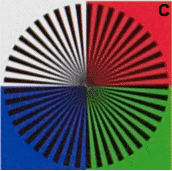
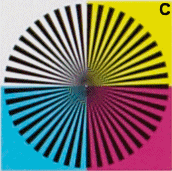
The above images are animated and should switch back and forth between Sigma SD14 (S) and Canon 5D (C). You can see how the 5D has the edge in some areas but not others. The 5D boasts final image resolution of 4368 x 2912 while the SD14 offers a final resolution of 2640 x 1760 which equates to 12.7 MP for the 5D and 4.6 MP for the SD14. When comparing final image sizes, the 5D has 65% more pixels in both directions (horizontal and vertical), however, it isn't surprising that the 5D can't capitalize on more than a fraction of that 65% in reality and falls short on detail for saturated colors. My findings that the 5D slips ahead of the SD14 on B/W resolution while falling behind (either via resolution or sharpness) in some saturated colors is expected, really. The color interpolation algorithms used to reconstruct a full color image from a single-color-per-pixel photograph are quite complex and between antialiasing filters and the logic needed to guess two thirds of the information at each pixel, there is understandably some resolution loss in the process before the 5D spits out that final photo. I believe that the star sector resolution test is a much more accurate method of determining real world resolution since in real photographs, we have more than just horizontal and vertical lines. Determining resolution by looking at a B/W chart with mostly horizontal and vertical lines is really of little merit when comparing different technologies such as Bayer versus full color capture because it does not adequately expose the weaknesses of the Bayer design and those are weaknesses that definitely show up in real photographs.
Revised (3/17/07): What about "real photos"
Wouldn't it be nice if the inconsistencies in resolving power of the Bayer sensor design were limited to only red and black mathematically derived resolution targets! One of the first criticisms to any scientific test seems to be, "but that problem will never appear in real photos". Sadly, this is not the case for the Bayer sensor as the issues of edge blurring and inconsistent resolving power across subjects of varied color are present in many "natural" shots that contain saturated colors. The issue is particularly noticeable in bright colored flowers and also fabrics where texture such as thread weave brings the inevitable blurring of the Bayer sensor design to the surface. In real shots, I'm finding upsampled SD14 photos to be every bit as detailed as the 5D across the board and better for certain problem colors like deep reds and blues. Below are some 1:1 crops from a shot of the same flowers taken in raw mode on both cameras and developed without any tweaking of the images:
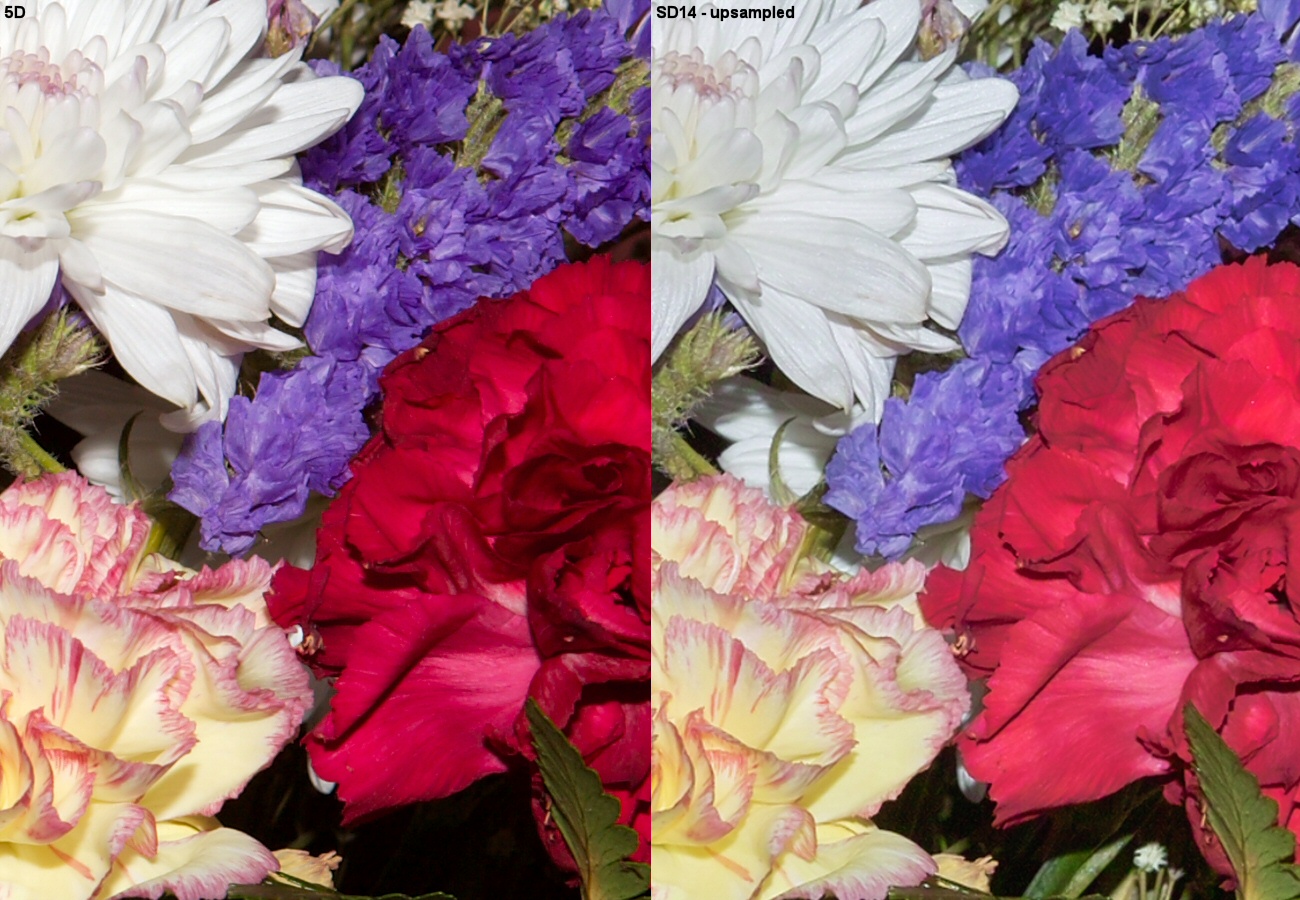
On the surface, it may seem unlikely that a 4.6 megapixel image upsampled to 12.7 MP can look as good or better than one that started as 12.7 MP but the proof is in the shooting! Even though the SD14 photo on the right above started as a much smaller image, when upsampled to match the resolution of the 5D, it holds up very well, easily matching the 5D in most areas while surpassing it in others. Where the SD14 holds consistent sharpness across the frame, the 5D has smudged over a bit of detail in areas notoriously problematic for Bayer sensors such as the red carnation and even the white flower where edge detail is being lost to the AA filter. Looking at the 5D shot, you'd be tempted to believe that the red flower is just a little out of focus because it's in front of (or behind) the other flower due to it not looking as sharp. In reality, all the flowers in the above crop are in the same plane relative to the lens. In addition, the shot was taken from a distance at f/11 so much of the depth of field is quite forgiving as well.
To be fair, the 5D did a little better overall with respect to color accuracy as the true purple tones of the flowers at the top/middle show more accurately in the 5D shot. The reds are actually somewhere between those depicted in the 5D shot and the SD14 shot as neither got the reds the perfect shade. Since I used Bibble 4.9 to process the 5D shots versus Sigma Photo Pro 3.0 for the SD14, I suspect much of the difference in color accuracy is due to the raw converter being used. I look forward to more raw conversion tools eventually supporting the SD14 in a truly color managed workflow.
Bottom Line
The bottom line here is that the SD14 appears to compare favorably to high end cameras having final images with significantly higher pixel counts. Is the SD14 equivalent to a standard 14 MP camera? As you can see from the above, that would depend on the circumstances and what you are shooting. I've upsampled a number of SD14 shots to 5D resolution and in most areas of near gray or only lightly saturated colors, there is actually very little visible difference between the SD14 and 5D shots as far as detail or resolving power. Throw in some saturated colors, however, and the detail and 3D appearance of the SD14 might just edge out the 5D! The consistency of sharpness and detail throughout the entire photo, no matter what color your subject, cannot be explained without being seen on the SD14. To some, the Canon name might be more important than the Foveon/Sigma innovation but I think the SD14 web site asks a relevant question with respect to brand loyalty by pointing out that technology that is fundamentally better may be worth more than an extra feature or two, or a metal body that can survive a 10 foot drop to concrete. At least until you drop your camera from 10 feet onto concrete. ;-) Different people will always have different needs and that's why there are so many cameras out there. So far, it looks like the SD14 lined up at the starting line and may well be jumping ahead of the rest of the pack at least as far as image quality. From what I can see by my initial look at this camera, image quality has pushed the SD14 ahead of competitors costing twice as much. Whether it can stay in front will depend on many factors not the least of which are reliability, usability from a real photographer's standpoint, and how it is received by the public. Speaking of public perception, one of my reasons for doing this article is to point out to potential buyers that the SD14 really is fundamentally better technology. Even though it's final images are 4.6 MP, it really is comparable to standard cameras that deliver final images 2-3 times larger in final resolution. For those who would be tempted to look at those 4368 x 2912 5D photos, comparing them to the 2640 x 1760 SD14 photos and say, "But what if I want to print a 24 x 36 inch print", don't be fooled by the Bayer resolution myth! The SD14 looks at a scene and records 14 million pieces of information in a balanced manner, sampling both color and resolution at the highest quality. Other ~14 MP cameras record the same amount of data, but give you a false sense of security by "stealing" two thirds of the color information from each pixel and attempting to use it for "resolution". Make no mistake, whether you want to call the SD14 a 4.6 MP camera or a 14 MP camera, it's in the running with the best on the market today and in my own personal opinion, beats most of them for total image quality!
Update (4/18/07): My SD14 develops major problems!
The above testing was done mostly in the confines of my small office and most shots were taken from a distance of about 6 ft to 8 ft. The SD14 focused normally in that range but once I started shooting macros and telephoto shots I noticed that I kept getting out-of-focus shots. After much testing, I found that the camera focuses in front of the subject in macro mode and well behind the subject when shooting a subject at the telephoto end of the lens (18-50 f/2.8 lens) when the subject is more than about 10 feet from the camera. This is repeatable time after time with only the center focus point being used. The camera only focuses properly when the subject is between about 4 and 8 feet from the lens and my other lens (15-30) behaves identically so I know it is the camera and not the lens. With firmware 1.00, I was also experiencing major problems with lockups, reboots, failure of the shutter to release, etc. so I sent the camera back outlining both problems in detail. I was surprised that I had to send the camera in and pay for the shipping (to Sigma service) myself when both Nikon and Canon have provided prepaid UPS boxes for the same service in the past but I just shrugged my shoulders and sent the camera to NY for service. Unfortunately after 10 days, I received the same camera back from Sigma with nothing but new firmware (focus issue not addressed) so I now need to ship the camera back to Sigma again and await a replacement. Hopefully the replacement will do better as I'm beginning to wonder if the Sigma body/firmware are worthy of the Foveon sensor. I'll be sure to update this page once I have the replacement camera.
Update (4/21/07): My replacement SD14
After the initial mixup where Sigma service sent my defective SD14 back to me, they turned it around very quickly the second time around and sent me a replacement. The new SD14 is working much better than the old one as far as focus is concerned. The new SD14 came loaded with v1.01 firmware yet it still has an occasional lockup that can sometimes even interrupt shooting. In addition, firmware 1.01 only fixes one of the three problems associated with shooting Adobe RGB JPEG's so JPEG shooting with Adobe RGB is still unreliable at best. The new camera with 1.01 firmware only locks up occasionally such as when shooting buffered shots quickly so it is certainly not as bad as the initial 1.00 firmware. Sigma appears to be going in the right direction. I'm hoping firmware v1.02 will cure the few remaining lockup problems and the remaining issues with Adobe RGB color space when shooting JPEG's.
Update (7/07/07): My final take
The last few months have given me more time to appreciate the SD14. Firmware v1.03 has cleared up all remaining issues I had with the camera and I find that it is becoming more and more my tool of choice for all around shooting. I've used both the Canon 5D and Sigma SD14 for the last four months, trying to give ample hands-on time to both cameras. They are both excellent cameras so I find myself sometimes preferring the Canon and sometimes preferring the Sigma. When the Sigma runs out of buffer and is slow to take the next shot, hunts a bit for AF, or occasionally gets a horrid auto WB, I find myself saying "The Canon wouldn't do that". Other days, I struggle to get a photo from the 5D to be as sharp as the SD14 without adding too much noise, or I come across another example of the "Bayer Blur" (below) where color detail gets smudged on the Canon and find myself saying, "The Sigma wouldn't do that". In the end, I tend to err on the side of image quality where I do think the SD14 has a slight edge under some conditions, and the result is less surprises like the one below.
The example below shows how I was recently shooting some Bottle Brush blooms with the 5D and the 5D literally ruined the shot making the bristles on the flower very jagged due to the tendency of Bayer cameras to lose significant resolution for certain primary colors. The word "ruined" may seem a bit extreme in this case, but my intention was to do a large print and the 5D let me down right where I needed the most detail in the shot: and it would certainly show on just about any print beyond 8x10. I reshot it several times with the 5D and each shot showed the same artifacts. I then shot it with the SD14 and got a beautiful shot the first time around. I show the example below only as a curiosity since the photos aren't cropped exactly the same nor did I do any color correcting (which I find the Sigma needs more often than the 5D), but the idea comes across. The shots below are raw conversions with default values and they stayed in TIFF format until saved for the web. I used ACR 4.1 for the 5D and Sigma Photo Pro 3.0 for the SD14. I did try Bibble and RSP for the 5D but the artifacts were just as bad on the 5D regardless of the raw tool used. As to the closeup of the green leaf, I could certainly have brought out more detail from the 5D shot using some extra sharpening, but I find doing that really brings out background noise in the 5D shots. The worst effect, of course, is seen in the bristles on the 5D shot where the 1/4 resolution red sensors just didn't have enough data to determine which way the lines were really going! You may be tempted to think that this is a once in a lifetime occurrence, but it happens quite often when shooting things like red flowers and blue fabric. Others have reported a blurring of the blue channel on the SD14 for red and yellow colors, but I haven't seen any such problem on my own shots up to ISO 800 (I rarely go beyond ISO 800). I've actually found the 5D to be noisier than the SD14 and the 5D is pretty clean although I have had some banding noise issues with the 5D!

I took a second more controlled shot (below) where I made sure to sharpen the 5D shot just enough to match the sharpness of the SD14. Intentionally trying to reduce artifacts on the 5D, I also made sure that the leaves under the blossom were in the same focal plane and I shifted the camera position so that no blue (sky) is showing behind the blossom as red on blue is the most difficult combination to render with good detail on a Bayer camera. As before, camera settings on both cameras were identical: ISO 100, 50mm, f/6.3, 1/200 shutter, and manual WB on WhiBal card. The only difference in the shot was that I had to move the 5D a bit closer to the flower in order to frame the shot the same since the SD14 has a 1.7x crop. This time, the 5D fairs a bit better on the green leaf below the blossom but the same stair-stepping artifacts are present in the bristles of the red flower in the 5D shot. The problem is not quite as pronounced with a red-on-green shot as it was above, but the jagged edges are still quite noticeable just viewing at 100% (no zoom). Also, take a look at the 200% zoom of the background from the same shot. The 5D shows significantly more visible noise.

Noise profile from the same shot:
| 5D 200% zoom | SD14 200% zoom |
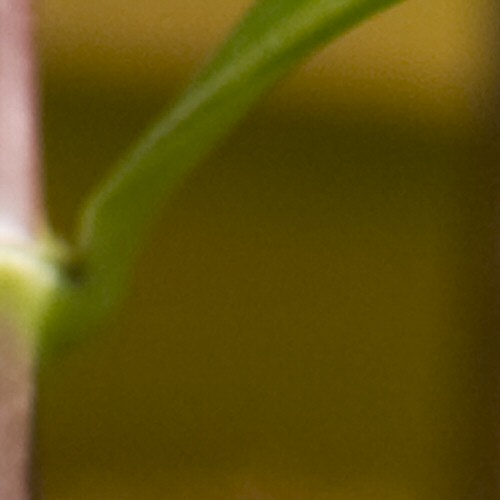 |
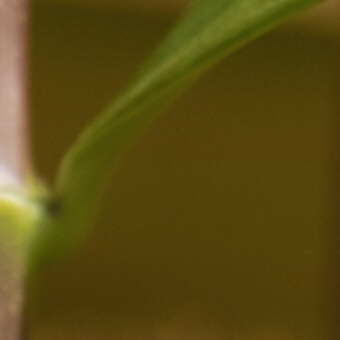 |
Update (7/11/07): One last set of photos to ponder
| Canon 5D 100% crop | Sigma SD14 100% crop |
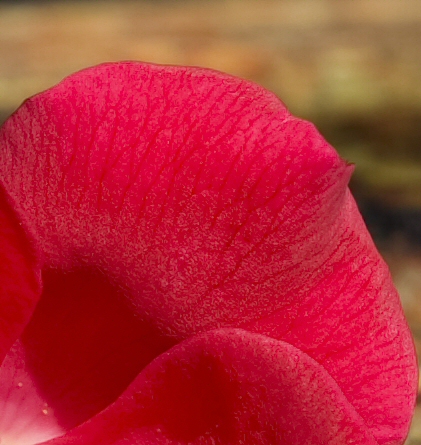 |
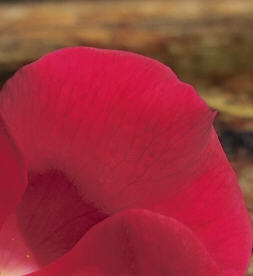 |
Full JPEG conversions of the above raw photos can be downloaded below so that the entire image can be examined. The focus point on both cameras was the middle of the crop above. This photo has been framed identically in both cameras and shows a receding fabric below the flower so that depth of field can be examined. Be your own judge. Personally, there are certain aspects of this photo that I think were dealt with better by the SD14 such as overall red resolution and other aspects where I feel the 5D had an advantage such as better/smoother separation of the RGB color channels. The phenomenon of smoothed-over detail in the blue and green channels on the SD14 can be seen in this photo. The more tests I do, the more I'm convinced that this smudging of the blue and sometimes green channel on red objects is caused not by noise reduction or smoothing, but rather by a propensity for the Foveon color separating algorithms to clip the blue/green channels at a certain point when rendering specific shades of red. Also worthy of note is that the 5D recorded what appeared to be specular reflections on parts of the flower petals making them appear almost oversharpened (and the photo was only sharpened enough to match the sharpness of the SD14 shot). Those specular reflections were not observed on the flower in person even when viewing under a 10x loupe. Here, it appears that the color separating process of the SD14 made the petals seem a little too velvety smooth while the 5D did the opposite, creating some extra frosting on the leaves. The real flower actually looked like a compromise between the two. Note that to minimize motion blur, both cameras were on a sturdy tripod and the shot was taken indoors using sunlight through a window.
Here are the full photos:
5D Full Res Flower (converted to JPEG from raw)
SD14 Full res Flower (converted to JPEG from raw)
Overall, my take on the SD14 is:
Pros:
Unrivaled sharpness/detail at the pixel level
Less surprises caused by inconsistent resolving power for different colors
Very accurate color IF you take the time to get a good WB
Very low noise under most shooting conditions
Final photos are smaller in size (easier to work with/transfer) yet contain more real data than cameras boasting 2x the final resolution
Cons:
Slow buffering may impede quick shooters
AF a little pickier than most: takes more practice to get good focus on the first try
Battery life not phenomenal
Auto WB sometimes way off, although easily fixed if shooting raw
Certain colors have a slight hue shift, particularly red and purple: hopefully SPP software can improve this in the future
That's about it for the major points. There are just as many cons as pros above, but I tend to put a lot of weight on final image quality where the SD14 really stands alone in today's camera market. Sure, there are other cameras that do just as well or better for your average photo, but in the end, the competitors sometimes fall flat when it comes to capturing fine color detail like that shown above. I have yet to see another reviewer really test this (properly). As a result, many reviewers tag the SD14 as more hype than hero as they tend to focus on B/W resolution charts or when they do test color detail, they make mistakes like not matching the lenses properly or using proper test patterns that really show the problems with Bayer cameras. I'm certainly not one who puts the SD14 in the hype category! To me, someone who knows the compromises made when sampling only one color per pixel, I can only hope the SD14 is one of many full color capture cameras to come! Not only do the benefits of full color capture show up in lab tests, they show up in the real world too. Who knows, maybe part of it is psychological. Now that I've shot with the SD14 and I've seen how the Bayer design can let you down, I'm aware of it and I know it can rear its ugly head at any time. ;-) I guess I just like knowing that the quality of my photos won't be driven by the color(s) of my subject. For that, I give the SD14 top honors as there really is nothing else in the running!
Other articles
Did you find this article interesting? I also write articles each month for Tech Corner at Steve's Digicams. Just go to Steve's Digicams and click "Tech Corner" from the main menu for a list of articles related to topics in digital imaging such as color management in general, specific techniques such as rendering intents, soft proofing, sharpening, understanding printer page size versus image size, and many more.